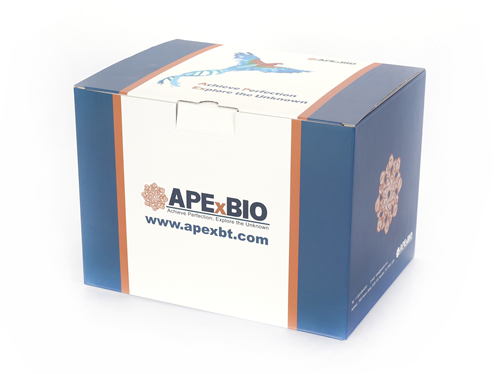- Home
- Signaling Pathways
- GPCR/G protein
- 5-HT Receptor
- Dihydroergotamine mesylate
Dihydroergotamine mesylate
Dihydroergotamine mesylate is a partial agonist for both dopaminergic and α-adrenergic receptors. Dihydroergotamine mesylate also acts as a full agonist for the 5-HT receptor, with IC50 values being 2?nM and 2.2?nM for human 5-HT1B and 5-HT1D receptors stably expressed in HEK?293 cells and C6 glioma cells, respectively. Like other potent 5-HT receptor agonists such as sumatriptan, dihydroergotamine mesylate has been approved for acute migraine therapy.?
References:
1.?Lesage AS, Wouters R, Van Gompel P, et al. Agonistic properties of alniditan, sumatriptan and dihydroergotamine on human 5-HT1B and 5-HT1D receptors expressed in various mammalian cell lines. British Journal of Pharmacology, 1998, 123(8): 1655-1665.
2.?Schaerlinger B, Hickel P, Etienne N, et al. Agonist actions of dihydroergotamine at 5-HT2B and 5-HT2C receptors and their possible relevance to antimigraine efficacy. British Journal of Pharmacology, 2003, 140(2): 277-284.
3. Villalón CM, Bom AH, Den Boer MO, et al. Effects of S9977 and dihydroergotamine in an animal experimental model for migraine. Pharmacological Research, 1992, 25(2): 125-137.
| Physical Appearance | White solid |
| Storage | Store at -20°C |
| M.Wt | 679.78 |
| Cas No. | 6190-39-2 |
| Formula | C34H41N5O8S |
| Solubility | insoluble in EtOH; ≥102.2 mg/mL in DMSO; ≥2.85 mg/mL in H2O with gentle warming and ultrasonic |
| Chemical Name | (6aR,9R,10aR,Z)-N-((2R,5S,10aS,10bS)-5-benzyl-10b-hydroxy-2-methyl-3,6-dioxooctahydro-2H-oxazolo[3,2-a]pyrrolo[2,1-c]pyrazin-2-yl)-7-methyl-4,6,6a,7,8,9,10,10a-octahydroindolo[4,3-fg]quinoline-9-carbimidic acid compound with methanesulfonic acid (1:1) |
| SDF | Download SDF |
| Canonical SMILES | C[C@@](/N=C(O)/[C@](C1)([H])C[C@]2([H])C3=C4C(C[C@@]2([H])N1C)=CNC4=CC=C3)(O5)C(N([C@]5(O)[C@]6([H])CCCN67)[C@@](C7=O)([H])CC8=CC=CC=C8)=O.CS(O)(=O)=O |
| Shipping Condition | Small Molecules with Blue Ice, Modified Nucleotides with Dry Ice. |
| General tips | We do not recommend long-term storage for the solution, please use it up soon. |
| Cell experiment:[2] | |
|
Cell lines |
LMTK- cells expressing 5-HT2B or 5-HT2C receptors |
|
Reaction Conditions |
30 min incubation |
|
Applications |
Dihydroergotamine (DHE) and its major metabolite 8'-hydroxy-DHE (8'-OH-DHE) acted as agonists for both 5-HT2B and 5-HT2C receptors in respect to cGMP production, with pEC50 values of 8.32 ± 0.09 for 8'-OH-DHE at 5-HT2B and 7.83 ± 0.06 at 5-HT2C receptors. |
| Animal experiment:[3] | |
|
Animal models |
Anaesthetized Yorkshire pigs |
|
Dosage form |
3, 10, 30 and 100 mg/kg i.v. |
|
Applications |
Dihydroergotamine mesylate elicited dose-dependent pressor and bradycardic responses which were probably mediated by its partial agonist action on α-adrenoceptors and D2 dopaminergic receptors. The carotid haemodynamic effects of dihydroergotamine mesylate consisted of a dose-dependent reduction of arteriovenous anastomotic blood flow and conductance and an increase in nutrient (tissue) blood flow and conductance. |
|
Note |
The technical data provided above is for reference only |
| ? |
References: 1. Lesage AS, Wouters R, Van Gompel P, et al. Agonistic properties of alniditan, sumatriptan and dihydroergotamine on human 5-HT1B and 5-HT1D receptors expressed in various mammalian cell lines. British Journal of Pharmacology, 1998, 123(8): 1655-1665. 2. Schaerlinger B, Hickel P, Etienne N, et al. Agonist actions of dihydroergotamine at 5-HT2B and 5-HT2C receptors and their possible relevance to antimigraine efficacy. British Journal of Pharmacology, 2003, 140(2): 277-284. 3. Villalón CM, Bom AH, Den Boer MO, et al. Effects of S9977 and dihydroergotamine in an animal experimental model for migraine. Pharmacological Research, 1992, 25(2): 125-137. |







